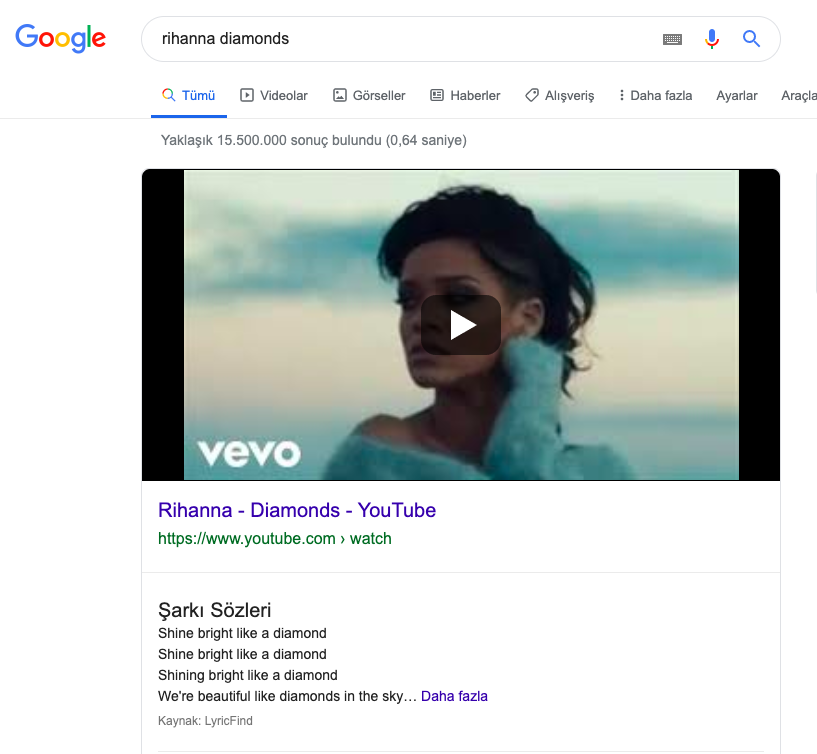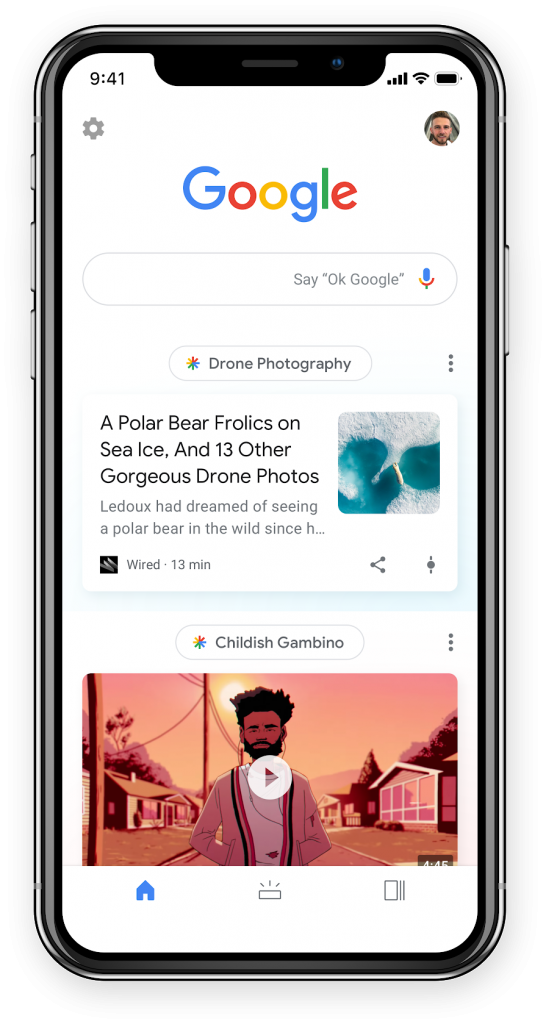What is the Meta Tag Update and Nosnippet Feature? How to use it?
On September 24, Google announced new meta tag properties and a new HTML attributes. The announcement posted on Google's Webmasters Central blog is particularly relevant to content owners and websites that do not want their content to be published in the featured snippet, which we call zero-rank. As you know, in addition to structured data fields, Google can include text content as featured snippets in search results. This created negative effects for sites that lost traffic because of their own content or competitor in this area. Take a song lyrics site as an example.
When we search a popular song's lyrics on Google, it is showing us all the lyrics of that song at zero-spot. This is most likely cut a lot of traffic of websites in SERP. As an example, when you search for Rihanna - Diamonds on Google, as you can see at the screenshot below, all lyrics are shown in zero-spot.

In this case, both competition and site traffic was reduced and at the same time creating legal problems, and this was a matter of serious debate. However, Google seems to put an end to these discussions by announcing the new meta tags and data-nosnippet, which we will review in detail below. With new tags, site owners will be able to prevent their content from being displayed as snippets, but this brings about different discussions. When you remove your content from the zero result, can you trust that your competitors will do the same, or even if the zero result leads to traffic loss, can you give up competing with your competitors for this area? We will see the answers to these questions in late 2019 and 2020 together. Now let's examine the new tags and features together.
New Meta Tags and Usage
First of all, after the new improvements, Google has introduced new features that will enable us to show featured text snippets more effectively. The first of these is to mark/restrict our snippets using meta tags. Google explains how to use these new features in the content it publishes as follows;
nosnippet
The nosnippet tag is an existing tag that tells Google bot that we don't want any written snippets to be shown from the relevant page.
max-snippet:[number]
With this new tag, we can specify the maximum text length of the snippet for our page in characters.
max-video-preview:[number]
With this tag, we can specify the length, in seconds, of an animated video preview.
max-image-preview:[setting]
Finally, using this tag, we can determine the way images are displayed in thumbnails in 3 different ways. For this, we can specify the size to be shown according to our decision by writing “none”, “standard,” or “large" in square brackets. In addition, in a scenario where we will use several of these features, we can specify them to the search engine bot with a single tag instead of adding individual tags.
For instance;
<meta name="robots" content="max-snippet:50, max-image-preview:large">
Data-nosnippet
In addition to the meta tags, a new markup has been announced that will allow us to control the rich text content that was previously randomly selected and shown in the search results. In HTML, we can add “data-nosnippet” parameter in span, div and section elements so that the relevant section is not selected as text snippet. Thus, although we cannot determine at least directly which part to use, we can determine which parts do not want to be used for this snippet. You can see an example usage scenario in the following code.
<p>This part can be shown in snippets.
<span data-nosnippet>This part won’t be shown in the snippet</span>.</p>
<div data-nosnippet>Won't be shown in the snippet</div>
<div data-nosnippet="true">This part is not included in the snippet</div>
<div data-nosnippet>text part</html>
<!-- unclosed "div" will then be included in all content -->
<mytag data-nosnippet>some text</mytag>
<!-- Invalid: span, div, or section tag does not exist.--
Usage in AMP Format

AMP, accelerated mobile pages, is a mobile page acceleration feature, which, as you know, offers pretty good features for websites to increase mobile site speeds and is shown with a lightning bolt next to the page in search results. This feature also allows us to use traffic channels such as Google Discover and our content will perform better and increase the chance of getting high ranking. AWith the new features announced, we have gained important features for our amp pages, especially in terms of visual dimensions. Using the meta tag features above, we'll be able to optimize our visual dimensions to be shown in search results. We can use the "none" or "standard" tags, especially if we don't want to use large images. However, when we look at data from Google Discover, we can see that using high-quality images of at least 1200 px provides better ranking and performance.
We also recommend that you pay attention to using the visual size and the size attributes specified in the meta tag. This is because if you select a large-size display for a low-resolution image, this may lead to deterioration of your visual quality (this feature has not yet been tried). We see that the use of large size and high quality images increases the clickthrough rate by 5%, the time spent on the page by 3% and the user satisfaction by 3%. The full text of the Google announcement is currently available in English here.
FAQ About The New Copyright Law in France

Q- Which publishers will be affected by the new copyright law?
A- Since the current law does not include a list, Google says it is mandatory to conduct initial reviews in a way to cover a large audience and without a guide. According to the announcement, the next update will include all European journalism transactions that are part of Google News. It is said, however, that non-journalistic sites, such as, but not limited to, academic journals, personal blogs, or the content of sports teams, are not included. If your site is not included in this process, you can include it through Search Console, or if you think your site was accidentally added / want to exit, you will still be able to do so from your Search Console account.
Q- How do I know if my site was affected by this update?
A- Google says that we can see the current status of your site through your Search Console account about whether your site is affected by the European Press Publication law.
Q- My site was not eligible to update, I have configured. When can I see the changes?
A- Google says that the status of affected sites has been updated within a few days and that the update is available across the site and is quickly understood without having to crawl individual URLs.
Q- Is there a way to apply meta tags throughout the site?
A- Unfortunately, there is nothing that can be done about it. Meta tags need to be added individually for all pages, and pages need to be scanned and discovered one by one. However, it may be possible to see add-ons that we can do bulk edits in the near future.
Q- Can I set different snippets for each page?
A- Yes. Thanks to the new meta tags, it is possible to make different snippet adjustments for each page with new features. In addition to the short summary we have compiled for you above, you can reach the original version of the announcement in English here.
Attention for the Wordpress and Yoast SEO Plugin Users

In parallel with these developments, there was an important development that closely concerns the users of Yoast SEO plugin. Yoast announced that it has introduced an update to prevent text snippet and video preview for all its users in parallel with Copyright Laws in France. So if you are a Yoast user who wants your text snippets to appear in the zero rank, you need to correct this by using the Yoast settings or by manipulating the code. Otherwise, as mentioned above, if Google crawls your pages, you may lose your text snippet fields, if any. Click here for the original full text of the announcement. However, the content is in English.
So What Should You Do?
First of all, it is possible to change this tag automatically. You can find the wpseo_robots filter and make your changes here. In addition, Yoast has begun collecting requests for users who wish to access this area via its own panel, and has announced that it will be able to add this feature to versions 12.2 or later released on October 1st.
Final Thoughts
The new meta-tag features, more often a legal protection, offer very useful features for site / content owners who don't want to display their content in zero rank. With these new features, you can prevent your content from being used as a text snippet, choose the length, or specify which sections of the content you don't want included in this field. In addition, the size of your visuals and video preview time with these new features can also be configurable. However, we need to pay particular attention to the fact that in parallel with the Copyright Law in France, the Yoast SEO plug-in will prevent text snippet display and video display for all users. As Zeo Agency, we recommend you to change this code from the relevant filter or plug-in if you want to be in the zero rank. Otherwise, you may lose your video preview and text snippet across your entire site. What do you think about the new changes? If you have any questions, please feel free to contact us via comments. We would glad to answer your questions.















